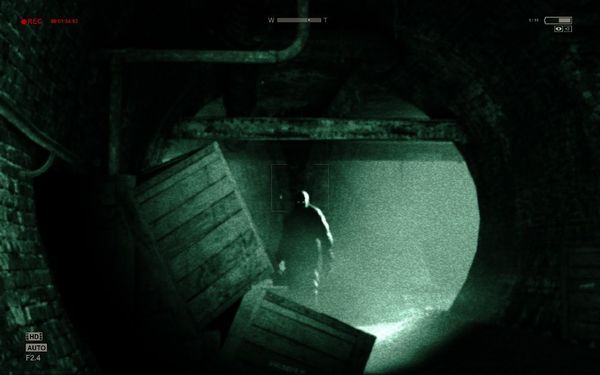Outlast (PC)

Survival horror is a notoriously tricky genre—especially in videogames, where players are accustomed to blasting enemies into giblets with rocket launchers. Survival horror operates by straight-jacketing the typical power fantasy, by making the player feel helpless and vulnerable. Running and hiding are generally the two best tools at your disposal. Add appropriately creepy visuals, sound cues and story beats, and the combination can be remarkably effective.
Outlast, the new PC release from Montreal-based developer Red Barrels, follows in the tradition of predecessors like Silent Hill, Amnesia: The Dark Descent and the best game ever made about a murderous hobbit with giant scissors, Clock Tower. You’re cast as Miles Upshur, a journalist investigating mysterious occurrences at the decrepit Mount Massive Asylum in Colorado. As the most prudent of investigators, Miles enters the asylum—which is, of course, populated by homicidal mutated freaks—armed only with a video camera. Naturally, things go horribly wrong, and Miles is forced into a desperate battle for his life and sanity. So, par for the course.
For its first hour, Outlast feels promising. Navigating the ruined corridors of the asylum, you quickly pick up the game’s few mechanics: how to run, hide, sidle along ledges, squeeze between obstacles, open and close doors, and especially how to use your camcorder. Activating its night-vision mode is the only way to find your way in the darkness of the asylum. Like lantern oil in Amnesia, batteries are scattered around the environment. Scrounging for them becomes crucial, since night-vision rapidly drains your camera’s power. This is not a terribly original mechanic, but it’s an effective one; conserving battery power by only allowing yourself brief glances through the grainy green viewfinder adds to the tension created by the unnerving environments.
Outlast should be commended for its striking use of light (or lack thereof), which plays upon that most basic of human fears. There is always the threat of something horrifying lurking in a shadowed corner, which forces you to listen closely for every tiny sound cue—the rustling of chains, the patter of footsteps, the murmuring of the inmates hunting you. In moments where your night-vision illuminates the glowing eyes of an enemy, the effect is truly frightening. And although Outlast relies a bit too much on jump scares; for my taste, I won’t deny yelping out more than once during my seven hours with the game. Perhaps even more effective than the lighting in creating that tension is the original score, whose menacing strings keep the adrenaline coursing. Miles’ ragged breaths as he flees a pursuer or cowers in a locker serve the same function. From an audiovisual perspective, Outlast is a resounding success.
That’s why it’s so disappointing that the game undermines itself so often. Primarily, that’s because its story—revealed through document collection and occasional in-engine cut-scenes—is so flimsy it collapses under the slightest scrutiny. (As a side note, if we could get a UN resolution prohibiting writing on the walls with blood and Nazi mad scientists from games forever, that’d be grand.) It’s not unusual for horror stories to strain credulity, but the plot holes in Outlast are so wide that, by the end, I questioned the events of the preceding several hours—and not in a David Lynchian “was any of this real?” kind of way, but in a Saw VII “oh, so that sequence was just an excuse for more gore?” kind of way.
Outlast opens with a warning that it contains disturbing scenes of violence and gore. This is true. Nearly every hallway contains at least one eviscerated body or coil of entrails swimming in a pool of blood. But like the Saw films, once you reach a critical mass of gore, a massive tonal shift occurs. The film or game ceases to be about survival and instead becomes about revenge. (Or, in extreme cases, comedy, like Peter Jackson’s parody Dead Alive.) Outlast steps on its own foot by showing us too much gore too frequently; it’s much creepier when you only occasionally stumble upon something unspeakable.
